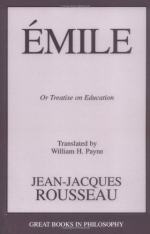Every one who has considered the manner of life among the ancients, attributes the strength of body and mind by which they are distinguished from the men of our own day to their gymnastic exercises. The stress laid by Montaigne upon this opinion, shows that it had made a great impression on him; he returns to it again and again. Speaking of a child’s education he says, “To strengthen the mind you must harden the muscles; by training the child to labour you train him to suffering; he must be broken in to the hardships of gymnastic exercises to prepare him for the hardships of dislocations, colics, and other bodily ills.” The philosopher Locke, the worthy Rollin, the learned Fleury, the pedant De Crouzas, differing as they do so widely from one another, are agreed in this one matter of sufficient bodily exercise for children. This is the wisest of their precepts, and the one which is certain to be neglected. I have already dwelt sufficiently on its importance, and as better reasons and more sensible rules cannot be found than those in Locke’s book, I will content myself with referring to it, after taking the liberty of adding a few remarks of my own.
The limbs of a growing child should be free to move easily in his clothing; nothing should cramp their growth or movement; there should be nothing tight, nothing fitting closely to the body, no belts of any kind. The French style of dress, uncomfortable and unhealthy for a man, is especially bad for children. The stagnant humours, whose circulation is interrupted, putrify in a state of inaction, and this process proceeds more rapidly in an inactive and sedentary life; they become corrupt and give rise to scurvy; this disease, which is continually on the increase among us, was almost unknown to the ancients, whose way of dressing and living protected them from it. The hussar’s dress, far from correcting this fault, increases it, and compresses the whole of the child’s body, by way of dispensing with a few bands. The best plan is to keep children in frocks as long as possible and then to provide them with loose clothing, without trying to define the shape which is only another way of deforming it. Their defects of body and mind may all be traced to the same source, the desire to make men of them before their time.
There are bright colours and dull; children like the bright colours best, and they suit them better too. I see no reason why such natural suitability should not be taken into consideration; but as soon as they prefer a material because it is rich, their hearts are already given over to luxury, to every caprice of fashion, and this taste is certainly not their own. It is impossible to say how much education is influenced by this choice of clothes, and the motives for this choice. Not only do short-sighted mothers offer ornaments as rewards to their children, but there are foolish tutors who threaten to make their pupils wear the plainest and coarsest clothes as a punishment. “If you do not do your lessons better, if you do not take more care of your clothes, you shall be dressed like that little peasant boy.” This is like saying to them, “Understand that clothes make the man.” Is it to be wondered at that our young people profit by such wise teaching, that they care for nothing but dress, and that they only judge of merit by its outside.




